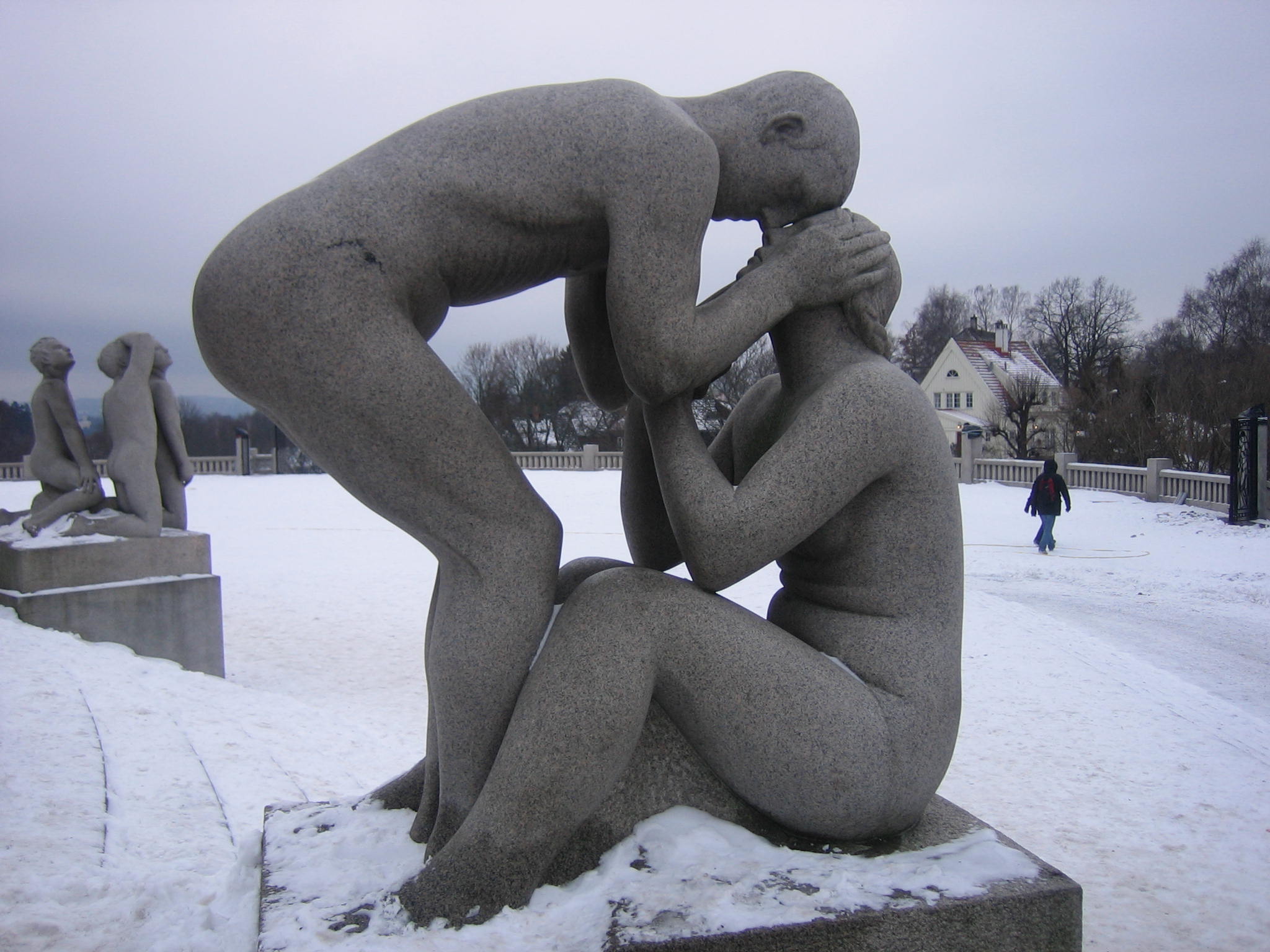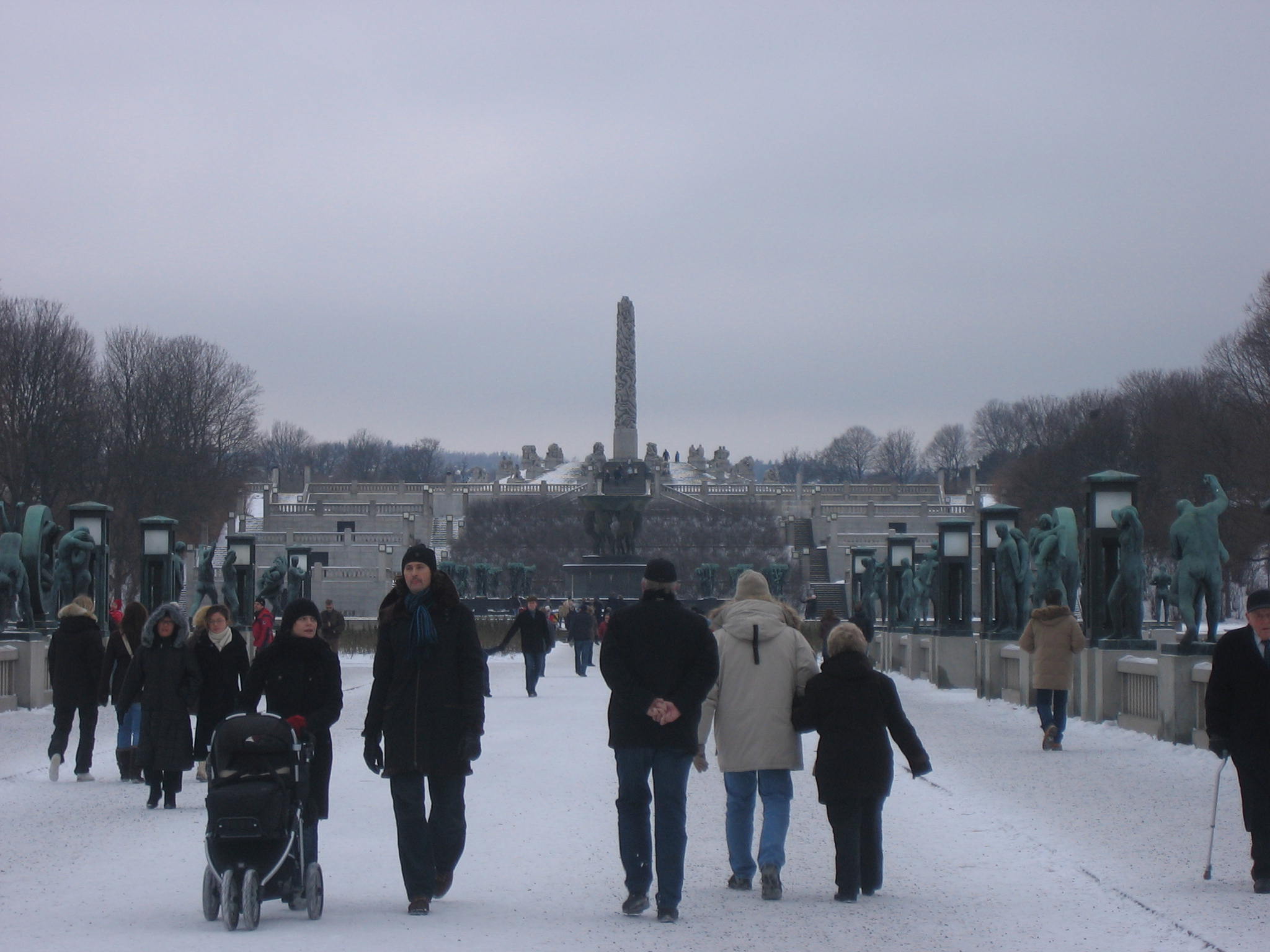Vigelandsparken Posted by kari on Feb 6, 2009 in Culture


 Vigelandsparken is part of Frognerparken, a large open park in the northwest corner of Oslo. Vigelandspark spans 80 acres with 212 bronze and granite sculptures designed by Gustav Vigeland between the beginning of the 20th century and 1944, when the giant monolith was finished. The park is one of the first sites I saw when I was first in Oslo and one of the last sites I visited before I left after my semester abroad. It is probably the most visited place in the capital, if not the country. The design, physical labor, and time that went into this park is absolutely astounding. Gustav Vigeland personally designed and sculpted each and every sculpture; the work was then contracted out to craftsmen to build the structures we see today. There are 6 different sections of the work of art: The Main Gate, The Bridge, The Children’s Playground, The Fountain, The Monolith Plateau, and the Wheel of Life.
Vigelandsparken is part of Frognerparken, a large open park in the northwest corner of Oslo. Vigelandspark spans 80 acres with 212 bronze and granite sculptures designed by Gustav Vigeland between the beginning of the 20th century and 1944, when the giant monolith was finished. The park is one of the first sites I saw when I was first in Oslo and one of the last sites I visited before I left after my semester abroad. It is probably the most visited place in the capital, if not the country. The design, physical labor, and time that went into this park is absolutely astounding. Gustav Vigeland personally designed and sculpted each and every sculpture; the work was then contracted out to craftsmen to build the structures we see today. There are 6 different sections of the work of art: The Main Gate, The Bridge, The Children’s Playground, The Fountain, The Monolith Plateau, and the Wheel of Life.
At any given time during the year between sunrise and sunset there are gobs and gobs of people walking the length of the park. I saw just as many people on the coldest winter day as I saw on the hottest summer day. That’s how spectacular these sculptures are. And they’re not just any old sculptures. They are fully nude sculptures of humans of all ages in all walks of life. I have never heard much about the reason for the theme of the work at Vigelandsparken, but it is pretty cool. Monolitten, the monolith, depicts the theme of the park really well. The sculpture is one solid granite stone that weighs several hundred tons and stands over 45 feet high. It is comprised of 121 human figures that appear to be climbing each other. Vigeland’s intention for this sculpture was to explain humankind’s powerful will to grow closer to the spiritual world.
Monolitten is a must see-the main attraction at the park. I also particularly enjoy the sculptures on the stairs that lead up to the monolith plateau. The stairs are decorated with quite large sculptures of humans depicting the “circle of life.” Some of them are very serious, such as the a grieving couple, while others are very light-hearted, such as the young father with his children playing on his back. The ability of Gustav Vigeland to portray so many human emotions in these sculptures is remarkable. And the best part is that you can get up close to them. I’m not sure if the city enjoys it, but little children climb all over the sculptures all the time and I have never seen anyone respond disfavorably.
When Vigeland was a young adult, he left his home in southeastern part of Norway to learn to read and carve wood in Oslo. After a brief period at home following his father’s death, he traveled back to Oslo with the desire to become a professional sculptor. The young artist went on several trips around Europe to gain skill and experience and eventually returned back to Oslo, where he was given from the city an abandoned studio in which to work. After Norway became independent from Sweden in 1905, Vigeland was commissioned by the city of Oslo to create busts of several famous Norwegians to support and promote Norwegian history and culture. Shortly thereafter, he agreed to donate all of his work to the city in exchange for a bigger and better studio. And thereafter began his long and large project to create Vigelandsparken. Next time you are in Oslo, make sure to see it!

Build vocabulary, practice pronunciation, and more with Transparent Language Online. Available anytime, anywhere, on any device.
About the Author: kari
I attended St. Olaf College in Northfield, MN, where I majored in Norwegian and History. During college, I spent almost a year living in Oslo, Norway, where I attended the University of Oslo and completed an internship at the United States Embassy. I have worked for Concordia Language Villages as a pre-K Norwegian teacher and have taught an adult Norwegian language class. Right now, I keep up by writing this Norwegian blog for Transparent Language. Please read and share your thoughts! I will be continuing this blog from my future residence in the Norwegian arctic!



